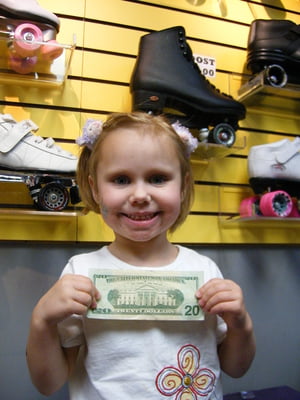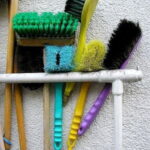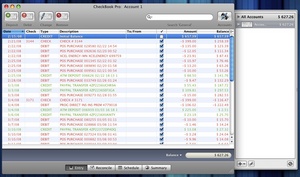Our children have a lot of toys…probably more than they need. However, they definitely do not have every single new toy that hits the market. We decided early on that if we run out and buy the latest superhero or electronic toy every time one hits the market, it will not only be bad for our checkbook, but bad for our children as well.
If a child gets everything he or she wants without any effort, what is this teaching them? Are they learning responsibility? Will the toy soon be tossed to the side with all of the other toys?
Our children appreciate getting gifts and receiving new toys because we are teaching them that it is a privilege and not a right; not something to be expected. Life is not going to hand them everything they want on a silver platter.
We teach them that it takes money to buy a toy and Mommy or Daddy has to work to earn the money to buy a toy. They learn that we also have to have money to eat, to pay for our house, to buy gas so that we can go places. They do not need to know exactly how much everything costs to understand the concept that it takes money to buy the things we need in our family. In addition to teaching these basic principals to our children as early as age three, we created a chore chart system that rewards the children and gives them an opportunity to earn money. This “reward system” is really paying off at our house.
When we made the decision to implement the chore chart and reward system, we also considered offering an allowance as well. We decided that we did not like the concept of just handing our children money regularly, no strings attached. Our children are young and they got really excited about the concept of doing extra chores to earn money so we did not want to “spoil a good thing.” This way, we have a methodical way of giving them money or buying them toys and the chore chart and award system is actually making our children get excited about doing chores around the house.
First, we made sure to explain the chore chart and reward system thoroughly to the children. The chart is on the bulletin board in the family room and is usually the first thing we look at in the morning.
Basically, the chore chart and reward system works like this:
Children earn stars on the chore chart The children earn “stars” every time they do something above and beyond the expected. If they help a family member out by going the extra mile or if they clean an area of the house without being asked, they get a “star.” The children get to put their own star on the chore chart as they earn it.
Regular chores do not qualify Both children have chores they are expected to do each day. They are appropriate to the child’s age and are not included in this reward system. However, if they fail to do chores within a day, a “star” is taken away.
Check progress regularly At the end of each week, we total the stars and talk about progress. We really make it fun for the kids and we cheer and clap and praise them. We also call grandparents and other family members to brag about how well they are doing, making sure the children are listening.
Stars = reward Our children do not earn a toy every week on the chore chart. We use columns and after three columns are filled up (approximately 30 stars) they earn $10. We give them the money and let them count it out. They each have a “special place” where they keep the money such as a wallet or bank that is off-limits for play. This summer, they have been earning an average of $10 every month once they fill the columns of the chore chart and reward system.
Learn about Money Our son is now six and he loves to count. He counts cars, people and sometimes just counts to over 400 randomly on his own. He is learning that it takes a lot more money for some of the pricier toys. He is motivated to count how much he has saved towards a particular toy he wants, the Sony Playstation PSP. One of his friends has a PSP, Gameboy, Xbox system, Playstation 3, a Nintendo system and every computer game and toy imaginable. He just turned six. In once wondered how you compete with that or explain? Even if we chose to spend our money on all of this equipment, we would not. There are not enough hours in the day for a child to enjoy playing with all of this, in moderation, and also get fresh air, read a book and do other physical activities. The answer for us was to enact this chore chart and reward system. Not only does the chore chart and reward system help our children learn how to count money but they learn that some toys take more money than others and it does not all just come free.
Value the toys instead of tossing them aside. Our son has almost earned enough to buy his Sony PSP. He is going to value that more than he would have if we just bought it for him and lined it alongside every other electronic gadget that hit the market.
Before you decide to create a chore chart and reward system, you will want to make sure you and your spouse are in agreement on how a “star” will be earned and how many stars it will take to earn a set amount of money. Also, I recommend you make your chart “fun” and display it in a spot so that you and you children will see it frequently.
Don’t forget to “catch” your child doing good deeds so they will see the value of earning these unexpected stars. And, it is ok to tell them that they will lose a star if they misbehave but be sure you give them a warning first, to be fair. When you treat your children in a respectful way, the child will respect you more for it.
Also, provide “extra” chores to earn stars. Our children get so excited about feeding the dog, sweeping the garage, organizing a toy cabinet or setting the table. We are surprised at how often we have to remind them to put a star on the chart because they just get so excited that they are helping out!
The children are happy earning the things they want to buy with this chore chart and reward system. We also make sure that they never brag to others about what toys they have, because it could hurt other children’s feelings. The chore chart is helping them learn the value of money, to take responsibility, and to help out around the house as well.








